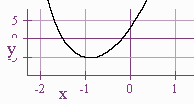Polynomial Equations
So far we have learned how to find the roots of a polynomial equation. If we have an equation that involves only polynomials we follow the steps:
Step 1. Bring all the terms over to the left hand side of the equation so that the right hand side of the equation is a 0.
Step 2. Get rid of denominators by multiplying by the least common denominator.
Step 3. If there is a common factor for all the terms, factor immediately. Otherwise, multiply the terms out.
Step 4. Use a calculator to locate roots.
Step 5. Use the Rational Root Theorem and synthetic division
to exactly determine the roots.
Example:
Find all the rational solutions of
(2x3 - 5)/4 = x - x2
-
(2x3 - 5)/4 - x + x2 = 0
-
(2x3 - 5)- 4x + 4x2 = 0
-
2x3 + 4x2 - 4x - 5 = 0
-
From the graph, we see that there is a root between -3 and -2 and a root between 0 and -1 and a root between 1 and 2.
-
Since the only possible rational roots are 1, -1, 5, -5, .5, -.5, 2.5, -2.5, the possible rational roots are -5/2 and -.5. Neither of these two are roots, hence there are no rational roots.
Example
Solve
x[x2(2x + 3) + 10x + 17] + 5 = 2

-
x[x2(2x + 3) + 10x + 17] + 3 = 0
-
2x4 + 3x3 + 10x2 + 17x + 3 = 0
-
We see that there is a root between -2 and -1 and between -1 and 0.
-
Our only possible roots are -1/2 and -3/2.
-
Using synthetic division, we see that -3/2 is a root, and the remainder is
2x3 + 10x + 2 = 2(x3 + 5x + 1)
which has no rational roots. Hence the rational root is -3/2 and using the calculator we see that the irrational root is 0.198.
Back to the Math Department Home
e-mail Questions and Suggestions